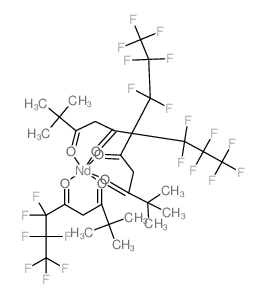6,6,7,7,8,8,8-heptafluoro-2,2-dimethyl-octane-3,5-dione; neodymium
Modify Date: 2025-08-25 18:22:41

6,6,7,7,8,8,8-heptafluoro-2,2-dimethyl-octane-3,5-dione; neodymium structure
|
Common Name | 6,6,7,7,8,8,8-heptafluoro-2,2-dimethyl-octane-3,5-dione; neodymium | ||
|---|---|---|---|---|
| CAS Number | 17978-76-6 | Molecular Weight | 1032.79000 | |
| Density | N/A | Boiling Point | 172.7ºC at 760mmHg | |
| Molecular Formula | C30H33F21NdO6 | Melting Point | 206-208ºC | |
| MSDS | N/A | Flash Point | N/A | |
| Name | Neodymium tris(hepta-fluorodimethyloctanedione) |
|---|---|
| Synonym | More Synonyms |
| Boiling Point | 172.7ºC at 760mmHg |
|---|---|
| Melting Point | 206-208ºC |
| Molecular Formula | C30H33F21NdO6 |
| Molecular Weight | 1032.79000 |
| Exact Mass | 1030.10000 |
| PSA | 102.42000 |
| LogP | 10.18110 |
|
Section 1: Product Identification Tris(6,6,7,7,8,8,8-heptafluoro-2,2-dimethyl-3,5-octanedionate)neodymium (III), 99% (99.9%-Nd) (REO) Chemical Name: Nd(FOD)3 CAS Registry Number:17978-76-6 Formula:Nd(C3F7COCHCOC4H9)3 EINECS Number:none
Chemical Family:metal fluorobeta-diketonate complexes Synonym:Tris(FOD)neodymium (III) Section 2: Composition and Information on Ingredients IngredientCAS NumberPercentACGIH (TWA)OSHA (PEL) Title Compound17978-76-6100%2.5mg/m3 (as F)2.5mg/m3 (as F) Section 3: Hazards Identification Emergency Overview:No particular hazard associated with this material. Primary Routes of Exposure:Ingestion Eye Contact:May cause slight to mild irritation of the eyes Skin Contact:May cause slight to mild irritation of the skin. Inhalation:May be irritating to the nose, mucous membranes and respiratory tract. Ingestion:Ingestion may lead to vomiting, exhaustion, anemia, convulsions and coma. Acute Health Affects:May be irritating to skin, eyes and respiratory tract. Product contains fluorine which, under certain conditions of use, decomposition or metabolism, may generate Chronic Health Affects:fluoride ion causing nausea, vomiting, labored breathing, hypocalcaemia, deterioration of bone and tooth structure, kidney and liver damage. NTP:No IARC:No OSHA:No SECTION 4: First Aid Measures Immediately flush the eyes with copious amounts of water for at least 10-15 minutes. A victim may need Eye Exposure: assistance in keeping their eye lids open. Get immediate medical attention. Wash the affected area with water. Remove contaminated clothes if necessary. Seek medical assistance if Skin Exposure: irritation persists. Remove the victim to fresh air. Closely monitor the victim for signs of respiratory problems, such as difficulty Inhalation: in breathing, coughing, wheezing, or pain. In such cases seek immediate medical assistance. Seek medical attention immediately. Keep the victim calm. Give the victim water (only if conscious). Induce Ingestion: vomiting only if directed by medical personnel. SECTION 5: Fire Fighting Measures Flash Point:none Autoignition Temperature:none Explosion Limits:none Extinguishing Medium:carbon dioxide, foam or dry powder If this product is involved in a fire, fire fighters should be equipped with a NIOSH approved positive pressure Special Fire Fighting Procedures: self-contained breathing apparatus and full protective clothing. Hazardous Combustion andIf involved in a fire this material may emit irritating fumes. Decomposion Products: Unusual Fire or Explosion Hazards: No unusual fire or explosion hazards. SECTION 6: Accidental Release Measures Spill and Leak Procedures:Small spills can be mixed with vermiculite or sodium carbonate and swept up. SECTION 7: Handling and Storage Handling and Storage:Store in a tightly sealed container. SECTION 8: Exposure Controls and Personal Protection Eye Protection:Always wear approved safety glasses when handling a chemical substance in the laboratory. Skin Protection:Wear protective clothes and gloves. Consult glove manufacturer to determine the proper type of glove. Ventilation:If possible, handle the material in an efficient fume hood. If ventilation is not available a respirator should be worn. The use of respirators requires a Respirator Respirator: Protection Program to be in compliance with 29 CFR 1910.134. Ventilation:If possible, handle the material in an efficient fume hood. Additional Protection:No additional protection required. SECTION 9: Physical and Chemical Properties Color and Form:blue-pink solid Molecular Weight:1029.77 Melting Point:no data Boiling Point:no data Vapor Pressure:130C (.01mm) Specific Gravity:no data Odor:None Solubility in Water:insoluble SECTION 10: Stability and Reactivity Stability:air and moisture-stable solid Hazardous Polymerization:none Conditions to Avoid:contact with strong oxidizing agents Incompatibility:oxidizing agents, active metals Decomposition Products:carbon dioxide, carbon monoxide, organic fumes, fluorinated organic fumes and neodymium oxide SECTION 11: Toxicological Information RTECS Data:No information available in RTECS. Carcinogenic Effects:No data available Mutagenic Effects:No data available Tetratogenic Effects:No data available SECTION 12: Ecological Information Ecological Information:No information available SECTION 13: Disposal Considerations Disposal:Dispose of according to local, state and federal regulations. SECTION 14: Transportation Shipping Name (CFR):Non-hazardous Hazard Class (CFR):NA Additional Hazard Class (CFR):NA Packaging Group (CFR):NA UN ID Number (CFR):NA Shipping Name (IATA):Non-hazardous Hazard Class (IATA):NA Additional Hazard Class (IATA):NA Packaging Group (IATA):NA UN ID Number (IATA):NA SECTION 15: Regulatory Information TSCA:Not listed in the TSCA inventory. SARA (Title 313):Not reportable under SARA Title 313 Second Ingredient:None SECTION 16 - ADDITIONAL INFORMATION N/A |
| EINECS 241-901-0 |
| neodymium 6,6,7,7,8,8,8-heptafluoro-2,2-dimethyl-3,5-octanedionate |
| neodymium fod |